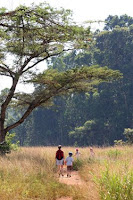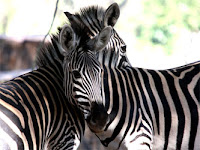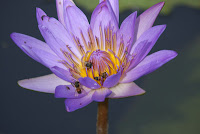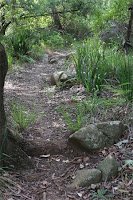 Continuing where I left off on baby steps... if you'd like to take a self-guided walk in Swaziland, possibly the easiest and most accessible option is the Hippo Trail at Mlilwane Wildlife Sanctuary.
Continuing where I left off on baby steps... if you'd like to take a self-guided walk in Swaziland, possibly the easiest and most accessible option is the Hippo Trail at Mlilwane Wildlife Sanctuary.Easy? Well, its fairly flat most of the way varying between 699m and 764 metres in terms of altitude. Total distance is 6.3km and the circular walk is easy completed in between 2 and 3 hours.
Accessible? Mlilwane is right in the middle of Swaziland and close to the highest concentration of tourism accommodation in the country, the Ezulwini Valley. The sanctuary is open sunrise to sunset for day visitors and there is a nominal entry fee. Entry is free for WILD card holders.
The trail itself is interesting enough to keep most walkers fully occupied, either with bird or wildlife spotting, or in negotiating the track itself. There are plenty of small banks to climb or descend, roots to step over and pole bridges to balance across. In terms of difficulty I would think that most folk will manage it, although elderly walkers would need to be fairly solid on their feet and/or closely assisted. If in doubt rather walk out and back from the camp starting point, because the sections departing and returning to the camp are the easiest and flatest gradients to negotiate with fairly consistent trail surfaces.
For younger walkers the trail is a must. On my most recent outing Anita (my wife) and I were accompanied by our children Kei (8yrs), Paige (6yrs) and Paige's friend Elle (6 yrs) and they had a ball. A good break along the way is advised though.
The trail can be undertaken in a clockwise or anti-clockwise direction. I prefer anti-clockwise, heading straight out from the camp, past the display of snares collected by rangers. The trail here runs roughly parallel to the main access road, but being along the edge of "the shallows", a man-made wetland area linking the big dam with the hippo pool in the camp, it gives far greater opportunity for wildlife viewing. We saw zebra, blesbok, warthog, impala and an ostrich alongside the trail and spurwing geese, a hamerkop, egrets, herons and kingfishers in the water.

Crossing the dam wall, its worth keeping an eye open for hippo, crocodiles, a resident fish eagle and numerous other waterbirds. Stay well away from the waters edge, the crocodiles here are huge, dangerous and will not hesitate to snatch anyone silly enough to splash their feet in the water. You have been be warned !
On the far side of the dam the trail leaves the open grassveld of the Central Plains area and heads through a tall gum forest. This is a remnant forest from the farming era that predated that park's establishment. The trees provide nesting for black sparrowhawk, Crowned eagles and offer welcome shade on hot days.
Further on the trail weaves its way through tall dongas (gulleys), which are another reminder of the areas's history, having been a tin mine in the early 1900's. The tall red banks provide a stark reminder of the destructive nature of this style of erosion mining, but all is not negative, because the banks are ideal nesting sites for birds such the White-fronted Bee-eater, which is prolific in the area. Half-way down the trail a massive nesting site is passed on the right, from which, if you approach quietly a sudden explosive rush of birds will emerge, wheeling away into the sky above.
This area also provides a real insight into the difficulty of eliminating alien vegetation from disturbed areas, as it is infested with lantana, wattle, mauritius thorn and bugweed. No amount of burning, chemical control or physical bush-clearing has been successful in eliminating this scourge and the park authorities are now forced to settle on only preventing its further spread.
 At the top end of the circle the trail crosses from the Mhlangeni drainage line across to the Mhlambanyatsi River, which is one of two rivers passing through the sanctuary. Visible to the north is the Nyonyane Mountain peak, otherwise known as the Rock of Execution. Along the river, the natural riverine vegetation and bubbling clear waters are alive with bird, insect and animal life. A dip in the water is a welcome relief on hot days, but ensure that this is done only in the shallow rock pools - the reed-lined river further down is crocodile territory.
At the top end of the circle the trail crosses from the Mhlangeni drainage line across to the Mhlambanyatsi River, which is one of two rivers passing through the sanctuary. Visible to the north is the Nyonyane Mountain peak, otherwise known as the Rock of Execution. Along the river, the natural riverine vegetation and bubbling clear waters are alive with bird, insect and animal life. A dip in the water is a welcome relief on hot days, but ensure that this is done only in the shallow rock pools - the reed-lined river further down is crocodile territory.Returning to the camp, the trail follows a contour above the river that offers expansive views across the plains below. We added wildebeest, nyala and kudu to our checklist, as well as plenty more zebra, impala and warthog, all of which are so relaxed that you walk past only a few metres away from them.
Back in the camp, the swimming pool, restaurant, braai and toilet facilities invite further relaxation... so why rush ?



